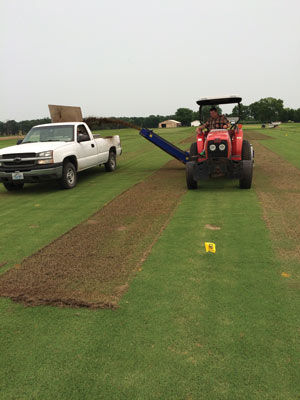 Researchers at the University of Missouri are conducting a three-year field experiment to determine whether fraze mowing can be incorporated into a management program that will result in faster curative control of and recovery from spring dead spot on bermudagrass.
Researchers at the University of Missouri are conducting a three-year field experiment to determine whether fraze mowing can be incorporated into a management program that will result in faster curative control of and recovery from spring dead spot on bermudagrass.
Plots were inoculated with the pathogen (Ophiosphaerella herpotricha) in 2013, and the experiment was initiated after initial symptom development in 2015.
The experiment was a split-plot design, with fraze mowing as the main plot in combination with subplot treatments of nitrogen source, manganese or the fungicide penthiopyrad. Plots were either not cultivated or were fraze-mowed at a depth of 0.16 or 0.31 inch on June 30, 2015.
Every week for six weeks after fraze mowing, nitrogen was applied as calcium nitrate or ammonium sulfate at a rate of 0.5 pound nitrogen/1,000 square feet. For the manganese treatment, 2 pounds/1,000 square feet of manganese sulfate was applied with fertilizer every other week. Plots were treated with the fungicide penthiopyrad on June 30 and Oct. 14 at a rate of 0.7 ounce of Velista (Syngenta)/1,000 square feet, or left untreated.
In the first year of study, spring dead spot was not significantly affected by the nitrogen source or manganese treatments. Disease severity was lower in plots fraze-mowed at 8 mm than in plots that were not fraze-mowed, and was lower in fungicide-treated plots than in plots without a penthiopyrad treatment.
Interestingly, no difference was observed between plots treated with a fungicide but not fraze-mowed, and non-fungicide treated plots that were fraze-mowed aggressively at 0.31 inch.
This study is ongoing to examine long-term treatment effects.
— Gerald (Lee) Miller, Ph.D., Daniel T. Earlywine and Brad S. Fresenburg, University of Missouri, Columbia
An article on this research was published in International Turfgrass Society Research Journal, 2017, 13(1):225-228. doi:10.2134/itsrj2016.10.0839
Teresa Carson is GCM’s science editor.